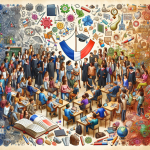
Spotlight on Innovation: How French Secondary Schools Are Adapting to Change
May 31, 2025
Diversity and Inclusion in French Secondary Education: Progress and Challenges
May 31, 2025
The world of language learning is traditionally dominated by textbooks and grammar exercises. However, educators are increasingly recognizing the immense value of integrating creative arts into language instruction. By melding music, visual arts, and other creative forms into French lessons, students can engage more deeply with the language while enjoying an enriched artistic experience. This multidisciplinary approach not only elevates language acquisition but also enhances cultural understanding, emotional connection, and creativity.
The Power of Music
Learning Through Song
Music has long been a powerful tool for language learning. Songs are a natural way to immerse students in the sounds and rhythms of French. Lyrics often introduce vocabulary and idiomatic expressions that might not surface in standard lessons. For instance, using the works of French artists like Édith Piaf or Stromae can expose students to rich storytelling entwined with emotional depth.
Encouraging Pronunciation
Singing in French can also help students with pronunciation and intonation. The musicality of the language encourages them to mimic sounds accurately, strengthening their phonetic skills. Activities such as karaoke or sing-alongs can be incorporated into the curriculum, creating an interactive atmosphere that makes learning enjoyable.
Cultural Connection
Music also serves as a gateway to understanding cultural nuances. Discussions about the themes in songs, the historical context of musical movements, and their impact on society can provide deeper insights into French culture.
Visual Arts as a Learning Medium
Art Interpretation
Integrating visual arts into language lessons encourages students to express thoughts and emotions in French. Students can analyze famous artworks by French artists like Claude Monet or Henri Matisse, describing what they see, discussing the emotions evoked, or even creating their interpretation. Such activities not only build vocabulary but also develop critical thinking skills.
Creative Projects
Creating art can enhance language acquisition. Having students compose a visual narrative or a collage based on a specific theme in the French language allows them to practice vocabulary in context. For instance, they might illustrate a scene from a story read in class or depict their favorite French phrase visually.
Art and Culture
Discussing works of art also introduces students to the historical and social contexts of France. This exploration can lead to discussions about movements like Impressionism or Surrealism, enriching students’ understanding of French culture and history.
Drama and Role Play
Bringing Literature to Life
Introducing drama into French lessons not only makes learning dynamic but also allows for an in-depth exploration of literary texts. Performing scenes from French plays or acting out dialogues can significantly boost comprehension and speaking skills.
Emotional Expression
Role-play scenarios, such as ordering food at a café or conducting an interview, foster practical language skills in a supportive environment. Such activities also promote confidence, as students can experiment with language use in real-world contexts.
Connection to Identity
Through drama, students can explore their identities and experiences, creating a personal connection with the language. This engagement is often more memorable and impactful compared to rote learning.
Integrating Technology
Digital Art and Music Platforms
Today’s technology offers various platforms that can further enhance creative arts integration into French lessons. Online resources, such as music streaming services or digital art tools, allow students to explore contemporary French culture dynamically.
Virtual Collaborations
Students can collaborate on projects with peers from French-speaking countries using video chat platforms, sharing their artistic creations or musical performances in real-time. This interaction highlights the importance of community in language learning while creating authentic opportunities for practice.
Conclusion
Integrating creative arts into French lessons fosters a richer, more engaging learning environment that goes beyond traditional methodologies. By using music, visual arts, and drama, educators can enhance language acquisition, cultural understanding, and emotional connection to the language. This multidisciplinary approach not only captivates students but also nurtures their creativity, inspiring a lifelong passion for learning French. Embracing the arts in language education is not just an innovative strategy; it’s an enriching journey that celebrates human expression and connectivity.

